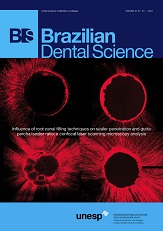Distalization of the entire maxillary arch with mini-implants in the posterior palatal alveolus- A case report
DOI:
https://doi.org/10.14295/bds.2020.v23i3.1946Resumo
A 22 year old male patient reported to the hospital with a chief complaint of forwardly placed teeth. On examination patient had Angle’s Class I malocclusion and proclination of the anterior teeth. There were signs of frictional keratosis on the buccal mucosa. Treatment plan was to extract the third molars alone and distalize the entire maxillary arch with palatal mini-implants. 0.022 MBT brackets were bonded on the buccal aspect. 0.019” x 0.025” stainless steel wire was placed sequentially. Mini-implants were placed on the posterior alveolus on the palatal surface of maxilla. Retractive force was applied from an attachment bonded on the palatal aspect of the maxillary canine. Patient was reviewed periodically. Comparison of pre-treatment and posttreatment results revealed that the entire maxillary arch intruded and translated distally with a counterclockwise rotation of the mandible with reduction in LAFH. There was a mild reduction in inter-canine with marginal expansion in the premolar and molar region. An improvement in facial profile was noted with no sign of root resorption. Thus, the posterior alveolus may be considered as a new and appropriate site for placement of mini-implant to bring about distal movement of the entire maxillary dentition.
Keywords
Orthodontic anchorage procedures; Bone screw; Palate.
Downloads
Downloads
Publicado
Como Citar
Edição
Seção
Licença
TRANSFERÊNCIA DE DIREITOS AUTORAIS E DECLARAÇÃO DE RESPONSABILIDADE
Toda a propriedade de direitos autorais do artigo "____________________________________________________________________" é transferido do autor(es) para a CIÊNCIA ODONTOLÓGICA BRASILEIRA, no caso do trabalho ser publicado. O artigo não foi publicado em outro lugar e não foi submetido simultaneamente para publicação em outra revista.
Vimos por meio deste, atestar que trabalho é original e não apresenta dados manipulados, fraude ou plágio. Fizemos contribuição científica significativa para o estudo e estamos cientes dos dados apresentados e de acordo com a versão final do artigo. Assumimos total responsabilidade pelos aspectos éticos do estudo.
Este texto deve ser impresso e assinado por todos os autores. A versão digitalizada deverá ser apresentada como arquivo suplementar durante o processo de submissão.




























